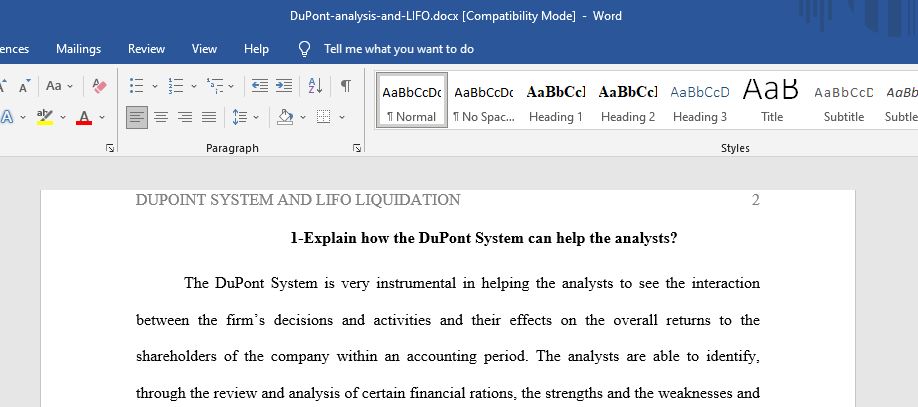Analyze the Advantages of the DuPont Analysis
Advantages of the DuPont Analysis
The DuPont analysis is a very important equity valuation tool which can assist company’s investors to make more informed decisions on their equity holdings in the company. The Du Pont system has the main advantage in that it provides the investors with a more comprehensive analysis of the overall financial health of the company in terms of its equity valuation better than what the other tools can provide. However, it also has a major disadvantage in that it relies so much on the data from a company’s financial statements which are prone to manipulation and this can interfere with the accuracy (Benjamin, Mohamed & Marathamuthu, 2018). It is an equity valuation approach which makes use of leverage ratios and financial ratios to expand the return on equity ratio (ROE) and turns it into a more detailed and reliable measure.
On top of the Return on Investment ratios, it also shows three other critical elements to the analyst and the shareholders. These three include the profitability as measured by the profit margin, the financial leverage as measured by the multiplier of assets/liability and operational efficiency measured by the asset turnover/utilization. Higher ROE as a result of better operational efficiency and better utilization of assets results into a favorable interpretation by the analysts. But if there is higher ROE due to the use of increased financial leverage then it means the higher ROE is not due to increased profits, hence a sign of risky investment for investors (Benjamin, Mohamed & Marathamuthu, 2018).
I think this is not the answer that i need
1-Explain how the Du Pont System can help the analyst.?
The Du Pont System helps the analyst see how the firm’s decisions and activities over the course of an accounting period interact to produce an overall return to the firm’s shareholders. <P>By reviewing the relationships of a series of financial ratios, the analyst can identify strengths and weaknesses as well as trace potential causes of any problems in the overall financial condition and performance of the firm.</P>
<P>The ratios which are looked at include the return on investment (profit generated from the overall investment in assets) which is a product of the net profit margin (profit generated from sales) and the total asset turnover (the firm’s ability to produce sales from its assets). Extending the analysis the return on equity (overall return to shareholders, the firm’s owners) is derived from the product of return on investment and financial leverage (proportion of debt in the capital structure). Using this system, the analyst can evaluate changes in the firm’s condition and performance, whether they are indicative of improvement or deterioration or some combination. The evaluation can then focus on specific areas contributing to the changes.</P>
Answer preview:
Words: 550

